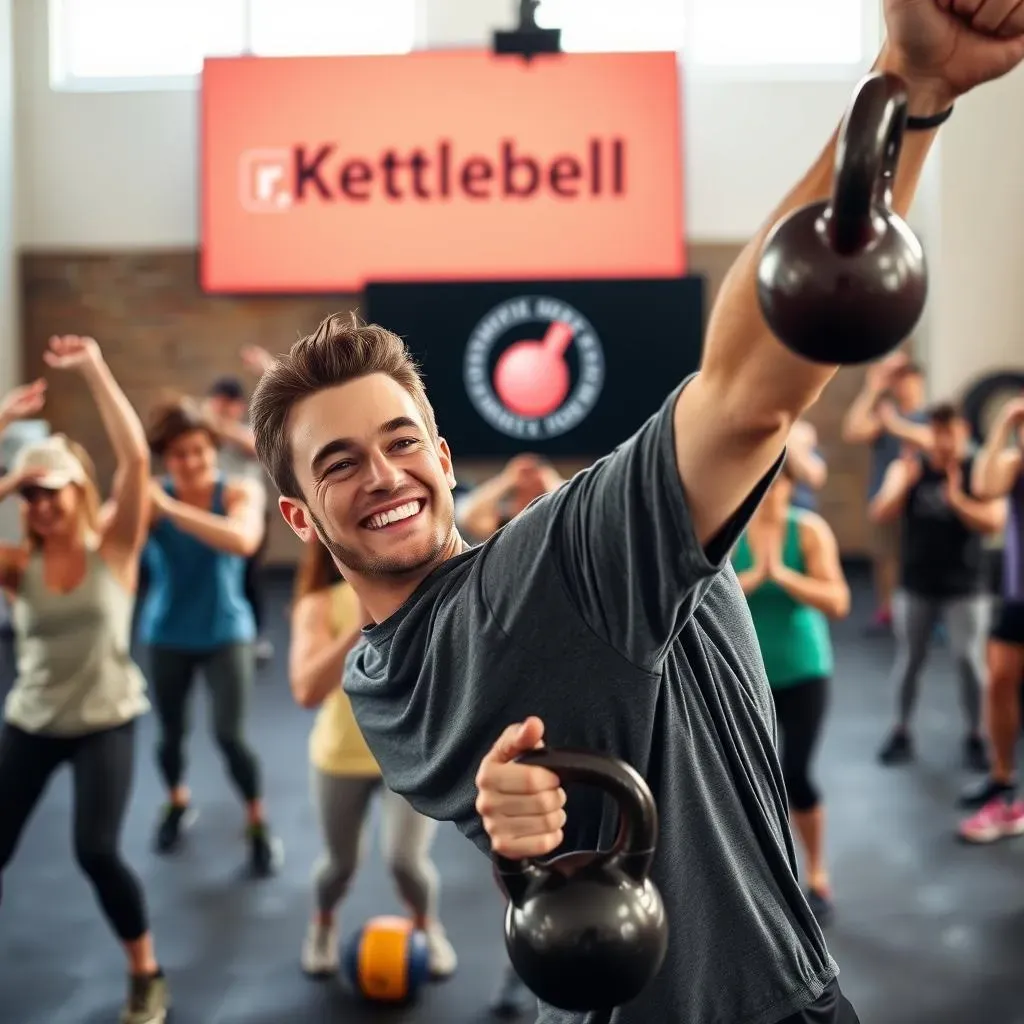Table of Contents
Ready to unlock your inner strength and sculpt a physique you'll be proud of? Then get ready to explore the world of kettlebell training! This comprehensive guide dives headfirst into the vibrant online community of r/kettlebell, your ultimate resource for everything kettlebell related. We'll start by introducing you to the supportive and knowledgeable community found on r/kettlebell, a hub for sharing experiences, tips, and motivation. Next, we'll break down the fundamentals of kettlebell swings, a cornerstone exercise that builds strength, power, and endurance. We'll cover proper technique, show you how to progress safely, and address common mistakes that can hinder your progress. Then, get ready to design your own killer kettlebell workout routines! We'll guide you through building full-body programs tailored to your fitness level and goals. Finally, we'll point you towards invaluable resources – from recommended books and videos to expert advice – to further your kettlebell journey. So, whether you're a complete beginner or an experienced lifter looking to refine your technique, this guide will equip you with the knowledge and inspiration to transform your fitness. Let's get started and unleash your potential with r/kettlebell!
r/Kettlebell: Your Online Community for Kettlebell Fitness

r/Kettlebell: Your Online Community for Kettlebell Fitness
Discovering the r/Kettlebell Community
So, you're thinking about diving into the world of kettlebells? Fantastic choice! But where do you start? That's where r/Kettlebell comes in – it's like a secret society of kettlebell enthusiasts, only it's totally open and welcoming to everyone. Think of it as your personal support group, your virtual training partner, and your go-to source for all things kettlebell related. It's a place where you can ask questions, no matter how silly they might seem (we've all been there!), share your progress, celebrate your victories, and even commiserate over those days when your muscles feel like lead.
What I love most about r/Kettlebell is the sheer diversity of the community. You'll find everyone from absolute beginners just starting their fitness journey to seasoned veterans who can swing a kettlebell like it's an extension of their arm. This means you'll find advice and support tailored to your specific needs, whether you're struggling with a particular exercise or looking for creative new workout ideas. It's a truly collaborative environment, where people are genuinely excited to help each other succeed.
Community Aspect | Benefit |
|---|---|
Supportive Atmosphere | Encourages beginners and celebrates successes. |
Diverse Skill Levels | Provides tailored advice for all fitness levels. |
Collaborative Environment | Promotes knowledge sharing and mutual support. |
Navigating the r/Kettlebell Landscape
Now, let's talk about how to actually navigate this amazing online community. The first thing you'll want to do is familiarize yourself with the subreddit's rules and guidelines. This ensures you're contributing positively and getting the most out of your experience. Once you're comfortable with the rules, start exploring! Browse through the posts, check out the FAQs (Frequently Asked Questions), and don't be afraid to ask your own questions. Remember, everyone started somewhere, and the r/Kettlebell community is incredibly patient and understanding.
One of the best ways to get involved is by participating in discussions. Share your own experiences, ask for advice, and offer support to others. You might be surprised by how much you can learn from simply engaging with other members. You can also search for specific topics using keywords, which can help you find answers to your questions quickly. And don't forget to check out the subreddit's wiki – it's a treasure trove of information on kettlebell exercises, workout routines, and more. It's a fantastic resource to bookmark and refer to regularly.
- Read the subreddit rules.
- Browse existing posts and FAQs.
- Actively participate in discussions.
- Utilize the search function.
- Explore the subreddit's wiki.
Mastering Kettlebell Swings: Technique, Progressions, and Common Mistakes

Mastering Kettlebell Swings: Technique, Progressions, and Common Mistakes
Mastering the Kettlebell Swing: The Foundation
Alright, let's talk kettlebell swings – the king of kettlebell exercises. It's deceptively simple, but mastering the technique is key to reaping its many benefits. Think of it like learning to ride a bike; initially, it feels awkward and clumsy, but with practice, it becomes second nature. The swing isn't just about brute strength; it's about using your hips and legs to generate power, engaging your core for stability, and maintaining a neutral spine to avoid injury. Start with a lighter weight to focus on perfect form, and gradually increase the weight as you build strength and confidence.
Imagine the movement as a pendulum: You initiate the swing by hinging at your hips, keeping your back straight, and driving the kettlebell backward between your legs. Then, explosively extend your hips and knees, propelling the kettlebell upward in a smooth, controlled arc. The movement should come primarily from your hips and legs, not your arms. Your arms act more as guides, allowing the kettlebell to swing freely. It’s a full-body movement, engaging your posterior chain—your glutes, hamstrings, and lower back—in a powerful way.
Body Part | Role in the Swing |
|---|---|
Hips | Primary power source |
Legs | Provide stability and contribute to power |
Core | Maintains stability and prevents injury |
Arms | Guides the kettlebell; minimal active effort |
Progressing Your Kettlebell Swings: A Gradual Ascent
Once you’ve nailed the basic kettlebell swing, it's time to progress. This isn't about lifting heavier weights immediately; it's about building a solid foundation and gradually increasing the challenge. One way to progress is by increasing the number of repetitions you perform. Start with sets of 10-15 reps, and gradually increase to 20-25 as you get stronger. Another approach is to increase the weight of your kettlebell. Remember, it’s better to use a lighter weight and maintain perfect form than to use a heavier weight and compromise your technique. This will prevent injuries and ensure you're maximizing the benefits of the exercise.
Consider incorporating variations of the swing into your routine. These variations can target different muscle groups or challenge your stability and coordination. For example, you could try the Russian kettlebell swing, which focuses more on the back and biceps, or the American kettlebell swing, which emphasizes the glutes and hamstrings. You could also try doing single-arm swings, which will challenge your balance and core strength. As you progress, you can also experiment with different tempos and pauses to further challenge your muscles and increase your strength.
- Increase repetitions
- Increase weight gradually
- Incorporate swing variations
- Experiment with tempo and pauses
Avoiding Common Kettlebell Swing Mistakes: A Pitfall Guide
Even seasoned lifters can fall prey to common mistakes. One frequent error is rounding the back during the swing. This puts immense strain on your spine and can lead to serious injury. Always maintain a neutral spine throughout the movement, engaging your core muscles to stabilize your body. Another common mistake is using your arms to lift the kettlebell. The power should come from your hips and legs. Your arms should simply guide the kettlebell's path. Finally, avoid swinging too fast or too aggressively. Control is key; focus on a smooth, controlled movement to maximize results and minimize the risk of injury.
Remember, proper form is paramount. If you're unsure about your technique, consider working with a qualified kettlebell instructor. They can assess your form, identify any weaknesses, and provide personalized guidance. Watching videos and reading articles is helpful, but nothing beats hands-on instruction from an expert. Investing in proper coaching can save you from injuries and help you maximize the benefits of kettlebell training. Don't rush the process; prioritize proper form over speed or weight. Slow and steady wins the race, especially when it comes to kettlebell training.
Building a Killer Kettlebell Workout: FullBody Routines and Programming

Building a Killer Kettlebell Workout: FullBody Routines and Programming
Designing Your Full-Body Kettlebell Workout
So, you've mastered the swing, now let's craft a workout that'll leave you feeling fantastic! The beauty of kettlebells is their versatility; they're perfect for full-body workouts that build strength, power, and endurance. We'll focus on creating routines that are effective, efficient, and most importantly, enjoyable. Remember, consistency is key, so choose a plan you can stick to. Start with shorter workouts and gradually increase the duration and intensity as your fitness improves. Listen to your body, rest when needed, and celebrate your progress. Don't be afraid to adjust the exercises and reps to suit your needs and preferences; it's YOUR workout!
A good full-body kettlebell workout typically includes a mix of exercises targeting different muscle groups. Think swings (obviously!), but also incorporate cleans, snatches, squats, lunges, rows, and presses. These exercises work multiple muscle groups simultaneously, making them incredibly efficient for building overall strength and fitness. Remember to prioritize proper form over lifting heavy weights. It's far better to perform fewer reps with perfect form than many reps with sloppy technique. This not only prevents injuries but also maximizes muscle activation.
Exercise | Target Muscle Groups |
|---|---|
Kettlebell Swing | Glutes, Hamstrings, Lower Back |
Kettlebell Clean | Shoulders, Traps, Quads |
Kettlebell Snatch | Full Body, Explosive Power |
Goblet Squat | Quads, Glutes, Core |
Kettlebell Row | Back, Biceps, Core |
Programming Your Kettlebell Workouts: A Strategic Approach
Now, let's talk about structuring your workouts. A common approach is to follow a push/pull/legs split. On “push” days, you focus on exercises like presses and cleans. “Pull” days are for rows and swings. “Leg” days incorporate squats and lunges. This prevents overtraining specific muscle groups and allows for adequate recovery. Alternatively, you can opt for full-body routines performed 2-3 times per week. This is ideal for building overall strength and conditioning. Remember to incorporate rest days into your program; this is crucial for muscle recovery and injury prevention. Without rest, your body can't adapt and grow stronger.
No matter which approach you choose, remember to gradually increase the intensity of your workouts over time. This could involve increasing the weight, reps, sets, or the difficulty of the exercises. Consider using progressive overload—gradually increasing the demands placed on your muscles—as a guiding principle. This approach challenges your body to adapt and grow stronger. Remember to track your progress. This helps you stay motivated and make informed adjustments to your program. You can use a simple notebook or a fitness app to record your workouts, reps, sets, and weight used. This data provides valuable insight into your progress and allows you to adapt your training accordingly.
- Push/Pull/Legs Split
- Full-Body Routines (2-3 times/week)
- Incorporate Rest Days
- Progressive Overload
- Track Your Progress
r/Kettlebell Resources: Books, Videos, and Expert Advice

r/Kettlebell Resources: Books, Videos, and Expert Advice
Top Kettlebell Books and Resources
Let's face it, the internet is awesome, but sometimes you need something tangible. That's where great kettlebell books come in. They offer structured information, detailed illustrations, and a depth that online articles often lack. I'd recommend looking for books that focus on proper form, progressive overload, and workout programming. Avoid anything that promises ridiculously fast results or focuses too heavily on gimmicks. Good books will emphasize safety and proper technique above all else. A few authors to look out for include Pavel Tsatsouline (renowned for his strength training expertise), Geoff Neupert (known for his focus on functional fitness), and StrongFirst (a well-respected kettlebell training organization). Their books and programs are excellent starting points for building a strong foundation in kettlebell training.
Beyond books, don't underestimate the power of well-made videos. YouTube is a goldmine, but be discerning! Look for videos from certified instructors who demonstrate proper form. Pay attention to the comments; often, you'll find valuable insights and corrections from experienced kettlebell users. Some channels to explore include those by StrongFirst, Brett Jones, and various certified kettlebell instructors. Search for videos that specifically address the exercises you're working on, focusing on clear explanations and demonstrations of proper technique. Remember, a video is only as good as the person making it. Always prioritize videos created by credible and experienced sources.
Resource Type | Advantages | Disadvantages |
|---|---|---|
Books | Structured information, detailed illustrations | Can be expensive, less interactive |
Videos | Visual learning, immediate feedback | Quality varies greatly, potential for misinformation |
Finding Expert Advice and Mentorship
While books and videos are great resources, sometimes you need personalized guidance. That's where seeking expert advice comes in. A certified kettlebell instructor can assess your form, identify areas for improvement, and create a customized training program. They can also help you avoid common mistakes that can lead to injury. If you're serious about kettlebell training, investing in a few sessions with a qualified instructor is a worthwhile investment. It’s like having a personal trainer, but specifically for kettlebells. They’ll not only teach you the proper form but also help you create a plan that aligns with your goals and fitness level.
Beyond formal instruction, remember the r/kettlebell community! It's a treasure trove of collective experience. Engage in discussions, ask questions, and learn from the experiences of others. While you shouldn't rely solely on online advice for your training program, it can be an excellent complement to formal instruction. The community can provide valuable insights, motivation, and support throughout your kettlebell journey. Remember, the collective knowledge of the community can be incredibly valuable, but always prioritize advice from certified professionals when it comes to your safety and training plan.
- Seek guidance from a certified kettlebell instructor.
- Engage actively in the r/kettlebell community.
- Combine professional advice with community insights.
- Prioritize safety and proper technique.